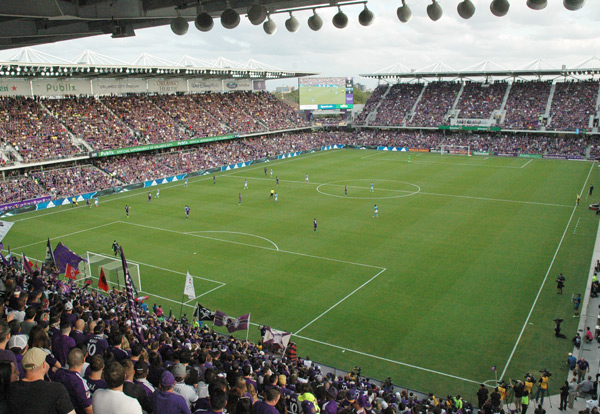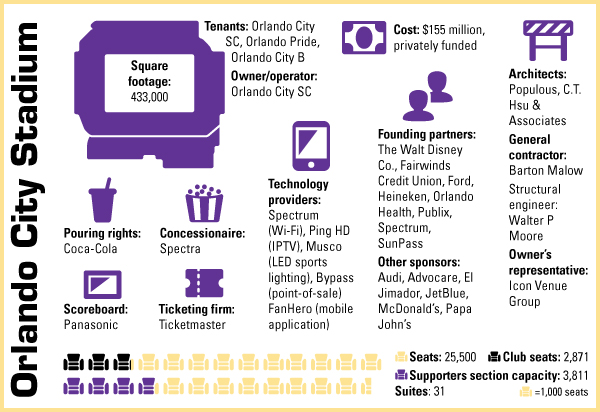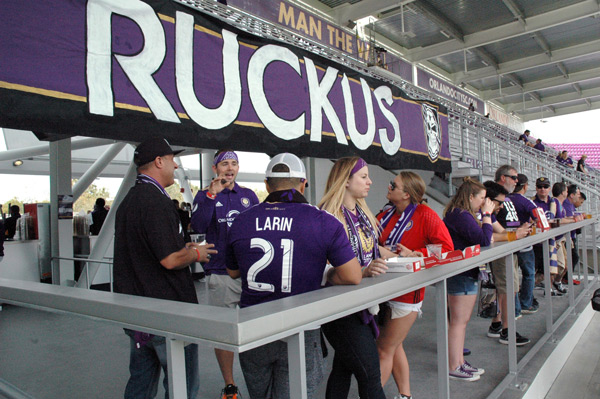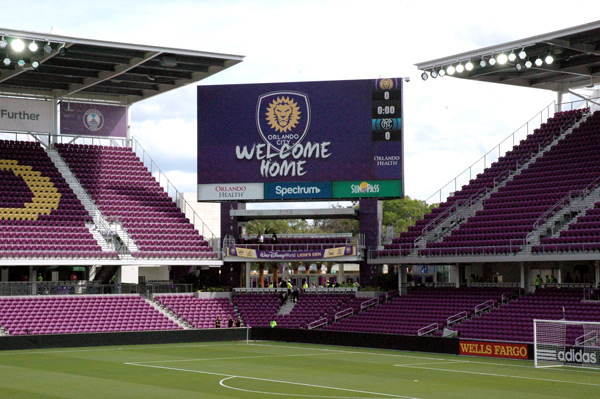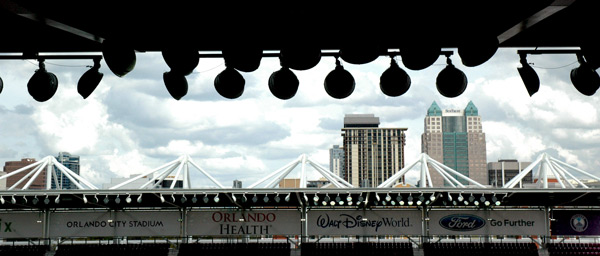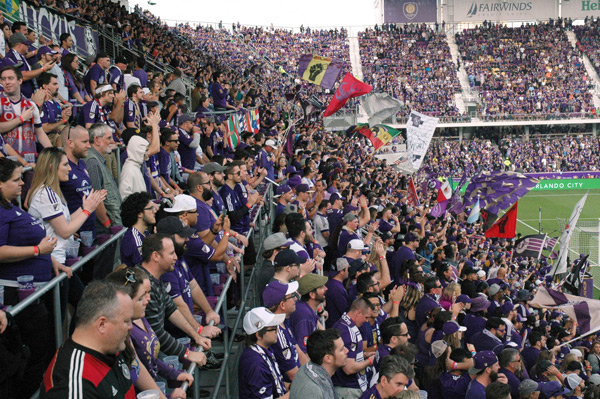 |
ALL PHOTOS BY DON MURET / STAFF
|
Three hours before kickoff at Orlando City Stadium, members of the Ruckus are in full roar just outside the doors, eagerly anticipating the $155 million facility’s first MLS match.
The Ruckus and the Iron Lion Firm, Orlando City SC’s two independent supporters groups, gain access to the stadium through an exclusive entrance one hour before other fans. Once inside, they collectively form “The Wall,” an intimidatingly steep section of 3,811 standing-room spaces on the stadium’s north end, complete with its own mini-concourse and terrace bar.
They set the tone for the raucous atmosphere inside the stadium March 5, when Orlando City SC posted a 1-0 shutout over New York City FC before a full house of 25,527.
Protected by front railings, each supporter stands on a numbered space on aluminum bleachers, creating a noisy foundation for the foot-stomping fans. They all have cup holders, an upgrade over other supporters sections, and a request they made when the club sought feedback on stadium development.
All told, it’s the largest safe standing zone incorporated into an MLS facility, and the stadium’s signature element modeled after the giant “Yellow Wall” at Westfalenstadion in Germany, home of the Bundesliga’s Borussia Dortmund.
“We’ve taken that influence and made it the Purple Wall,” said Rob Parker, Orlando City SC’s vice president of corporate partnerships, whose MLS tenure dates to the old Tampa Bay Mutiny in 1996, the year the league began play. “Its [33-degree rake] is as high as allowed by code. If you walk up those steps, your calves are burning by the time you’re halfway up.”
First Look podcast with Orlando and MLS discussion beginning at 20:20 mark:
The supporters section was part of team co-owner Phil Rawlins’ vision for the stadium. Coupled with the stadium’s steel roof canopies, built low and tight to trap sound, both elements make for a building much louder than Camping World Stadium, the team’s home for its first two MLS seasons.
Orlando City SC drew up to 60,000 fans there, and last season its average home attendance of 31,324 was second in MLS behind Seattle. But with no roof cover at the older facility, the sound would escape, turning down the volume on the team’s home-field advantage, executives said.
And at the new stadium? Shouldn’t be an issue. “It’s the idea of having our supporters put continuous pressure on the visiting team,” said Flavio Augusto da Silva, Orlando City SC’s owner.
The pressure was on Orlando City SC when progress on the stadium project slowed down over the past two years because of funding issues and the need to build a bigger stadium (see related story). Late in stadium development, the team expanded the venue to 25,500 seats because of overwhelming demand that had increased the team’s season-ticket base to 18,000. It’s the second-biggest stadium in MLS behind 27,000-seat StubHub Center, home of the Los Angeles Galaxy.
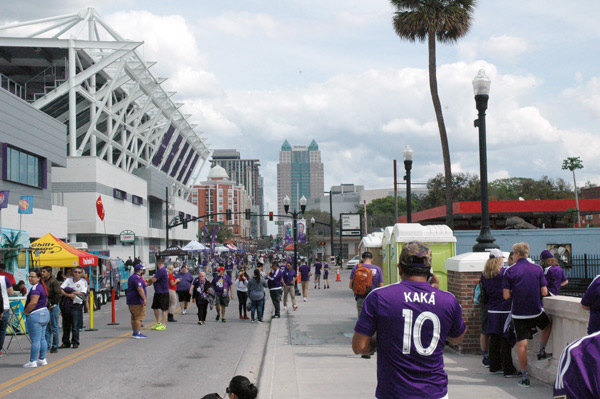 |
Orlando City SC fans congregate on Church Street outside the stadium, where team sponsors set up shop.
|
Despite those hiccups and some organizational changes after da Silva bought the team in 2013, Orlando City SC has grown to become a model for future MLS expansion teams to follow for successfully building both a franchise and a soccer-specific facility.
In downtown Orlando, the new stadium strengthens the city’s sports and entertainment district along the Church Street corridor that includes Camping World Stadium and Amway Center.
As the Orlando Magic moves ahead with its plan to develop a $200 million mixed-use project across the street from Amway Center — its version of L.A. Live — the addition of the MLS venue, and the events it will bring to the area, should help grow business for those new bars, restaurants and retail shops taking shape over the next several years.
The stadium itself is the city’s newest improvement just west of downtown in Parramore, a historic neighborhood with high unemployment and a low median household income.
Populous, the stadium’s architect, designed as many seats below grade and close to the field as possible as part of the team’s plan to create an intimidating presence, said Bruce Miller, Populous’ principal-in-charge of the project.
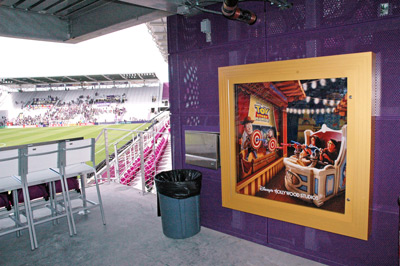 |
Gate sponsor Disney has a presence in the facility.
|
In general, the steep rake of the stadium, which extends to the upper deck along both sidelines, makes it feel much smaller and the open concourse keeps fans connected to the game and adds to the building’s intensity, Miller said.
On the premium side, there’s a big separation in both space and perspective between the two levels of suites on the stadium’s west side. The lower suite level, just 10 rows from the field, puts
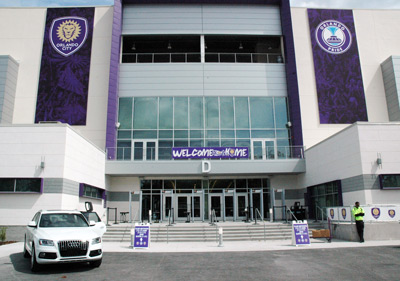 |
A sign at Gate D welcomes fans home.
|
those patrons in the middle of the action and at risk of being hit by errant balls, Parker said.
By comparison, at the very top of the stadium, the upper level of suites peers down on the field, providing a panoramic view for those who enjoy watching plays develop.
In the end, there was demand for all premium products. As of last week, one suite was left to sell among those available for long-term lease, Parker said. There are 31 total suites, designed in two groups of 14 and 28 seats. They sell for $100,000 to $150,000 annually, with five- and seven-year terms. This year alone, those deals cover about 50 matches among Orlando City SC, the NWSL’s Orlando Pride, and the parent club’s minor league affiliate, Orlando City B.
The stadium’s three all-inclusive clubs totaling 2,871 seats are sold out, confirmed Chris Gallagher, the team’s senior vice president of sales.
Club seat ticket prices per game range from $70 a person for the Midfield East Premium to $132 a person for the West Club and $346 a person for the Audi Sports Club at the stadium’s highest level. Beer, wine and soda are part of all club seat packages.
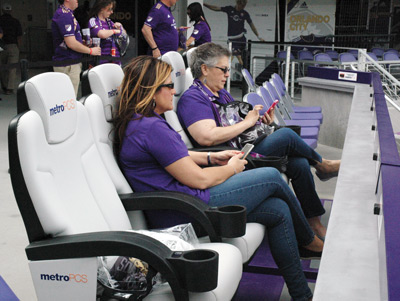 |
MetroPCS anchors a stadium corner with cushy seats.
|
The West Club has a long bar as its centerpiece, and concessionaire Spectra offers food options ranging from fresh seafood to hamburgers and hot dogs. Windows facing the field open up to catch the crowd noise.
The Midfield East Premium club, meanwhile, is an outdoor space framed by wood slats providing some privacy from the rest of the concourse on the east side. It’s branded by SunPass, the state of Florida’s electronic tollway pass program, which also sponsors the
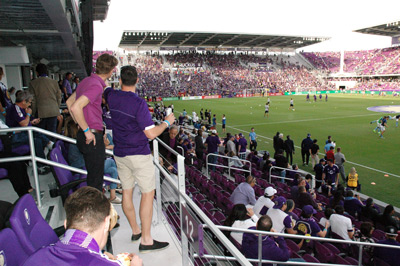 |
Fans watch from one of the 31 suites.
|
east entrance.
The Walt Disney Co. sponsors the southeast gate, where most fans enter from Church Street and the fan zone activation. The entrance is adorned with palm trees and an LED screen welcoming fans to the stadium and framed with large Mickey Mouse and Minnie Mouse medallions.
Cell phone carrier MetroPCS anchors the southwest corner with a small promotional group space.
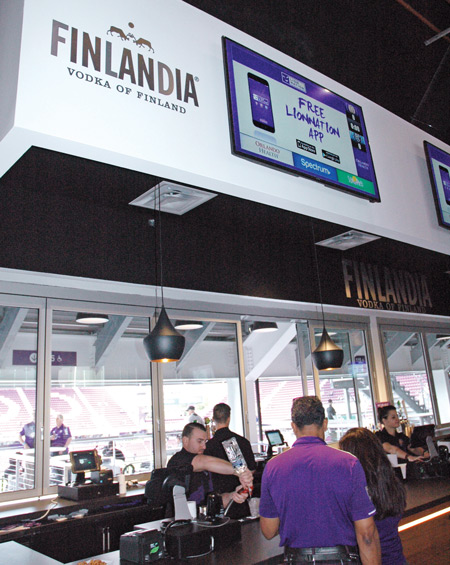 |
Finlandia Vodka branding hangs above the bar in the West Club.
|
The 26 ticketed seats include four cushy lounge chairs and phone chargers facing the field, which are an improvement over other stadiums whose plug-ins are set back on the concourse with no views to the game.
On the lower level, El Jimador tequila, in the northeast corner, and Heineken, on the south end, have branded bars that allow fans to grab a mixed drink and a beer and watch the game from those spaces. Jack Daniel’s sponsors a bar on the upper level.
All founding partnerships run in the mid- to upper six figures annually over four to seven years, and most are existing partners except for SunPass, Parker said. In some cases, the deals have been in place for almost three years, considering the stadium was supposed to open in 2016 before officials decided to expand it, he said.
The stadium’s LED sports lighting system leads to a clean look, eliminating the need for the tall light towers common at most venues. The nearly 600 access points for the Wi-Fi system provide three to four times the capacity now required for coverage, Parker said.
It’s all part of a stadium that’s heavy on technology, and is one of the first big-league venues to go paperless from the ground up for season-ticket holders.
“Soccer fans are young and connected now,” Parker said. “We don’t even have turnstiles. It’s all scanning digital tickets on … iPhones.”



